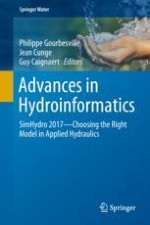2018 | OriginalPaper | Buchkapitel
Analysis of Flood and Dry Threshold Definition in Two-Dimensional Hydrodynamic Flood Modeling Tools
verfasst von : Leslie Salvan, Elodie Zavattero, Olivier Delestre, Philippe Gourbesville
Erschienen in: Advances in Hydroinformatics
Verlag: Springer Singapore
Aktivieren Sie unsere intelligente Suche, um passende Fachinhalte oder Patente zu finden.
Wählen Sie Textabschnitte aus um mit Künstlicher Intelligenz passenden Patente zu finden. powered by
Markieren Sie Textabschnitte, um KI-gestützt weitere passende Inhalte zu finden. powered by
